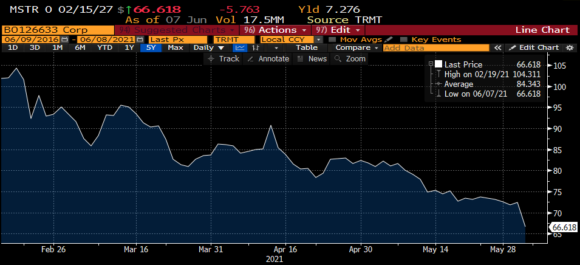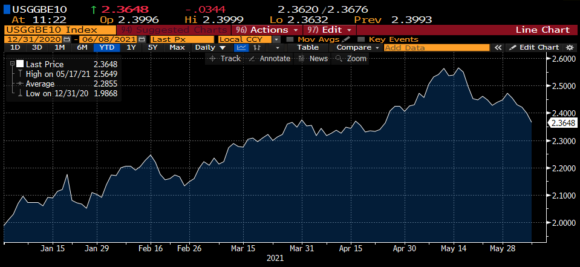Here are some things I think I am thinking about:
1) Moar Bitcoin! Back when I was a young adventurous person I used to have an exciting portfolio filled with interesting individual stock bets. But then I learned a bunch of economics/finance, got old/fat and turned into a pretty boring indexer. So I just love it when other people make wildly insane bets that I can write blog posts about. And I think that’s why I love the MicroStrategy story so much. In case you haven’t been following along, Michael Saylor, the firm’s founder has basically turned into a full blown laser eyed Bitcoin Maximalist. He’s convinced that the USD is going to blow up and that 15% annual inflation is coming. So he doesn’t want to hodl his firm’s cash in USD. But instead of going down the traditional finance route of owning, you know, fairly low vol inflation hedges like TIPS, REITs, gold or stocks, Saylor went straight for the highest vol asset around – Bitcoin. And they’re not just buying a little bit of it. They’re pouring all of the firm’s cash into it and then borrowing to buy even more.
As I’ve said before, I think this is imprudent. But I am just a boring traditional old finance guy who has been dead right about inflation for pretty much 20 years running. So who am I to talk? I kid, kind of. The thing that’s so fascinating to me about the MSTR bet is that Saylor’s a smart dude and his views upend so many of the traditional economic and finance narratives. I mean, if Saylor is right then most of the narratives in macroeconomics about inflation and money will end up looking, at a minimum, directionally wrong and perhaps fundamentally wrong. So, I kind of like the bet because it is forcing me to reconsider most of my priors. I’ve always been open-minded to crypto and I think it has tremendous potential. At the same time, there are tons of terrible narratives in the space. Or, at least narratives that I think are terrible that I could end up being very wrong about….
But here’s the thing about this bet, macroeconomic theories aside, that I just can’t stomach – Saylor is treating his firm like it’s a perpetual entity. So he’s aligned the firm’s assets to that duration. And one could argue that Bitcoin is a super duper long duration asset given the way the protocol is designed to issue new coins over the next 119 years. Here’s the problem with this – corporations are only perpetual in theory. In reality, they have to adhere to short-term liquidity constraints and most firms end up being much more short-term than their owners would prefer. And that’s where Bitcoin is a big f*cking mess because, with a standard deviation of ONE HUNDRED AND FIFTY PERCENT and regular 80% drawdowns, the asset exposes MicroStrategy to enormous downside risk in the case of some unusual circumstance such as a BTC crash that just so happens to coincide with a tech recession. The major worry is that the firm’s actual cash flows collapse at the same time the BTC position collapses. And then you risk a perverse feedback loop where the firm becomes a forced seller of BTC to create liquidity to remain solvent, which makes the entire BTC collapse worse, which snowballs, etc etc. It’s almost like Saylor has turned a nice little boring data firm into a financialized weapon of potential mass destruction. Except, unlike something like a mortgage backed security which is a diverse package of pretty safe low vol assets, the whole thing is collateralized by one insanely volatile asset.
Anyhow, like any good investment bank does, yesterday they announced a $400MM senior secured bond offering so they can buy more Bitcoin and I cannot wrap my head around this. The bond offers all the downside of Bitcoin with fixed upside. Why would anyone want to own this thing? But maybe the market is wising up. After all, the 2027 convertible bonds have really cratered in recent months. It’s amazing theater as far as corporate finance and economic theory goes. I hate to sound like I am sitting here with my popcorn cheering for Bitcoin to explode higher or lower to make this whole story even more exciting, but I am.

2) Even Moar Bitcoin! The other big Bitcoin news over the weekend was that El Salvador is going to accept Bitcoin as legal tender. Okay, this is super interesting at first. Except then you dive into it and it’s not. Here’s the thing. ES uses the USD already. In other words, they’re a foreign country that doesn’t even peg their domestic currency to a foreign currency. They literally say that that foreign currency is their currency. ES is a very unusual case as far as national “sovereignty” goes. I often point out that the MMT people abuse that term in the way they imply that any country can just choose to be “sovereign”. MMT advocates love to strut around slinging the term “sovereign currency issuer” like it’s something a country can just bestow upon itself. It’d be like throwing the word “rich” around as if anyone can just choose to be rich and have tons of credit giving them access to money and endless counterparties. “A rich person who has access to credit can never go bankrupt in the currency they use”. Thanks for that, MMT. But that’s just not how it works. A country can’t just choose to be sovereign and sovereignty is a rather dynamic state. MMTers love to point to the USA and other rich developed economies, but this is like claiming that people can’t go bankrupt because, hey, look, Warren Buffett and Elon Musk are a thing.
Anyhow, in the case of ES, they basically can’t remain sovereign because their economy is smaller than every single US state and they import a huge amount of USD from US based citizens and foreign trade. So the USD basically ends up swamping their domestic economy and creating a demand issue for the domestic currency. It’s a pretty unusual relationship as far as sovereignty goes, but the basic point is, they have to use a foreign currency.
The interesting thing about Bitcoin here is that ES basically has to operate like a currency user. They’re not that much different from a corporation that might seek to protect their USD exposure by holding other assets as reserves. You know, like a certain data management firm….And that’s what kinda makes this interesting. To me, the interesting aspect here is the way in which ES is choosing to protect their own portfolio from its own internal USD exposure. But again, rather than owning volatile USD denominated assets or even hard assets, they’re making Bitcoin the legal tender. Weird.
As for nations using Bitcoin – what would actually be interesting is if a wealthy sovereign entity chose to use something like Bitcoin. When I say interesting I actually mean that this would be pretty stupid. In the long-run there’s really no rational argument for fixing your money supply to an asset whose supply is fixed and whose value changes so wildly. It’s the same basic reason why the true gold standard doesn’t work. Fixing your supply of money to the supply of a scarce rock makes things rather inflexible. I mean, imagine being attacked by a neighboring country and you have to tell your citizens:
Due to yesterday’s 25% decline in Bitcoin I regret to inform you that we were unable to mobilize the military this morning to defend our country because we cannot purchase the gasoline necessary to refuel our vehicles.
I know it sounds crazy, but one of the essential elements of fighting any war is that you risk blowing up your domestic currency in the process. That’s one of the main causes of historical hyperinflations. You don’t just throw the kitchen sink at a war. You first print tons of money defending your country and then you wash the money down the sink and then you throw the kitchen sink at your enemy (with the money in it) and then you die. But if you can’t print your own money and actually rely on the rising value of some foreign currency to fund domestic war efforts then you might not even be able to defend yourself in the first place because you might be unable to fund the whole thing in the first place. One of the beauties of modern money is that it is inherently elastic. Its supply can increase and decrease as needed. This comes with the fun added risk of hyperinflation, but when used properly the elasticity of money is a huge strength, not a weakness.
3) About that Hyperinflation. There were lots of hyperinflation predictions coming out of the Pandemic. Like the 2008 crisis, I debunked most of them in real time. But I am admittedly still more concerned about inflation than I was in 2008. Still, I am on record saying that 3-4% core PCE inflation was the likely outcome here. So, nothing crazy like the 70s or Zimbabwe. And it’s interesting to see the bond market basically calling the hyperinflation bluff. Here’s 10 year break-evens moving slightly lower in the face of what should be a 4-5% CPI print on Thursday:

The bond market is basically predicting that the worst of the inflation might be behind us. So, it will be interesting to see how this plays out in the coming years. My guess is still that the 3-4% high will in fact be transitory, but that 2-3% might remain for several years. That could force the Fed to backtrack a bit and the yield curve could flatten some in the coming years. But USD collapse and/or high inflation? I still don’t see that as a likely scenario going forward.
Mr. Roche is the Founder and Chief Investment Officer of Discipline Funds.Discipline Funds is a low fee financial advisory firm with a focus on helping people be more disciplined with their finances.
He is also the author of Pragmatic Capitalism: What Every Investor Needs to Understand About Money and Finance, Understanding the Modern Monetary System and Understanding Modern Portfolio Construction.
